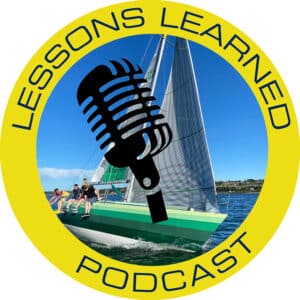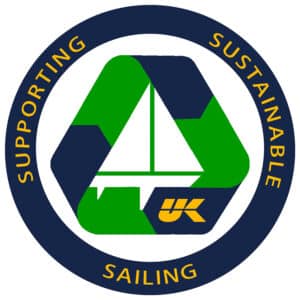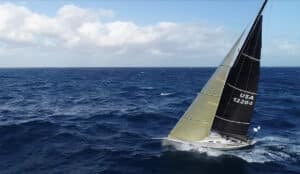Barry Hayes, owner of UK Sailmakers Ireland, explains what Lead is and why it is so important to sailmaking.
In sailmaking terms, the “Lead” is the distance between the sail plan’s Center of Effort (usually the working sail area which is the main and fore triangle “CE”) and the Center of Lateral Plane of the hull/foils (CLP). The relationship between the two effects a boat’s balance. Both the CE and CLP are approximate positions for the centers of pressure for the sail area and the hull underbody, respectively, and are used by yacht designers at the drafting stages to ensure that the keel and rig positions are well balanced. CE is always forward of CLP by a small amount when in equilibrium mode. This is because when the yacht heels, the CLP usually moves forward due to the new heeled hull form until it lies almost under the CE. The result: helm balance.
There is an amount of Lead (pronounced “leed”) that is acceptable, but if the design falls outside this area, the boat will have either too much weather helm (‘Lead’ is too short) or too much lee helm (‘Lead’ is too long). Too much weather helm results in drag (and in some cases helm exhaustion) and too much lee helm can result in dangerous situations such as crash gybes or worse, particularly if self-steering or helm issues come into play.
Determining just how much Lead is required depends on what type of boat you have. There is a rule of thumb that compares the Lead to the static waterline length. You divide the Lead by the waterline length and the result is: Percent of Lead (POL). Depending on the methods you are using to work out CLP, the allowable percentage can vary from 4% up to 17% after incorporating a number of factors. Hull shape is a key factor affecting Lead. A wide hull with hard bilges will require more Lead in static mode to compensate for the additional helm generated by the heeled hull shape. A narrow hull needs less Lead. Similarly, a tall rig creates more weather helm than a shorter one so the POL needs adjusting accordingly.
A yacht designer would adjust the lead by either moving the keel fore or aft or moving the CE of the sail plan fore/aft. They would get it perfect on paper (or CAD) so that, when launched, they will know that the boat will be well balanced with no vices from the outset. Interestingly, the reason they look at moving keel first is that this would require a very small change to affect Lead as opposed to moving the rig and resulting sail plan which would require bigger changes to have the same affect. When building a new boat from scratch. It’s always best to get extra holes in the mast step so the Lead can be easily adjusted.
If you have a pre-owned boat that is not well balanced and want to make changes, then the Lead can be corrected simply by adjusting the sail plan, mast rake, sail configuration or set up. Of course, you can also incur the expense of moving the keel, but this is a major refit and should only be looked at once you have looked through all other options above the waterline.
Windsurfers are a good example of how Lead works above the waterline. If you want weather helm, or to go to weather, you tilt mast aft till it is in that upwind groove and going well. When you want to fall off, you tilt the mast forward, thus moving the CE forward until you find yourself going downwind, and again within that sweet groove. Too much tilt aft you tack; too much forward you gybe. It’s a matter of finding that balance between the direction you are going in relation to the wind.
Of course, in most boats with a rudder, the direction the boat will travel is accomplished through steering. If the balance is off, the rudder ends up fighting the sails and the result is increased drag affecting performance and the loading up of everything attached to the steering such as autopilot and sheaves. How can you change Lead while sailing? You can start by adjusting the shape of the mainsail with halyard or outhaul tension or mast bend. A reef in the main also moves the CE forward thus reducing weather helm. Putting a smaller headsail on will also move CE forward thus reducing helm. Though a reduced main makes a bigger change than does a reduced headsail. It’s all about finding that balance between the two.
If you need your boat assessed or looked at to get the balance right; call your local UK Sailmakers loft. We are happy to help.





Hello. I have been thinking a bit about this as you describe here. But I myself have come to the conclusion that when the boat is tilted leeward, the tractive force is more or less on the side of the boat hull and keel. This would mean that the boat wants to go up against the wind due to the boat’s resistance in the water, and the forward thrust being at the side.
Sorry for my bad english!
Johnny S.
Hello. I have been thinking a bit about this as you describe here. But I myself have come to the conclusion that when the boat is tilted leeward, the tractive force is more or less on the side of the boat hull and keel. This would mean that the boat wants to go up against the wind due to the boat’s resistance in the water, and the forward thrust being at the side.
Sorry for my bad english!
Johnny S.